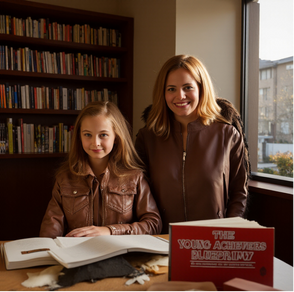When parents look at the current school environment, many feel something is missing. Yes, schools cover math, science, and language, but where are the real-world skills like communication, problem-solving, financial literacy, and initiative? The Young Achiever’s Blueprint by Rachel Morgan taps directly into that frustration, positioning itself as a practical framework that gives kids the knowledge and abilities schools often overlook.
n
The program is marketed as a low-cost, easy-to-implement system that requires just half an hour per week yet promises major transformation: children becoming problem-solvers, leaders, and confident decision-makers. But how well does it hold up against the bold promises?
n
In this extended review, I’ll go over what the program includes, its strengths, its weaknesses, and whether it’s worth the investment.
n
What the Program Promises
n
The pitch of The Young Achiever’s Blueprint is straightforward but ambitious:
n
It focuses on four “essential skills” schools neglect.
n
It delivers these skills through 12 guided projects.
n
Parents can support their kids in as little as 30 minutes per week.
n
It works for children aged 6–16, regardless of ability level.
n
Noticeable changes should appear within days of starting.
n
Parents will have access to bonus guides like The Confidence Code and Digital Success Secrets.
n
There’s a 60-day refund guarantee if no improvements are seen.
n
The system is presented as simple enough for any parent to use, while still ambitious enough to create what the sales page calls “extraordinary children.”
n
Strengths and Positive Aspects
n
There are several reasons this program will appeal to parents:
n
1. Clear and Organized Structure
n
The idea of 12 projects is easy to follow. Parents know exactly how many steps are involved, and “project-based” learning feels practical and less intimidating than an abstract curriculum.
n
2. Time-Friendly for Parents
n
The claim that it only requires 30 minutes per week makes it approachable. Many busy parents might feel overwhelmed at the thought of extra academic programs, but this low time commitment helps ease that concern.
n
3. Relevant Focus Areas
n
Problem solving, financial literacy, communication, and leadership are indeed valuable skills. If the projects teach these in concrete, hands-on ways, that would fill a real gap in traditional education.
n
4. Emotional Resonance
n
The program speaks directly to parents’ fears about their children being left behind in a competitive world. At the same time, it offers hope that transformation is possible with a simple step.
n
n
5. Affordable Price Point
n
At $17 (the promotional offer), it’s within reach for most families. Compared to private tutoring, after-school courses, or leadership camps, it’s positioned as a bargain.
n
6. Refund Policy
n
The 60-day money-back guarantee gives at least some level of safety for parents who are hesitant. It allows them to test the system without feeling completely locked in.
n
Weaknesses and Red Flags
n
Despite the attractive presentation, there are several issues that give pause.
n
1. Very Bold Claims
n
The suggestion that parents will see “remarkable changes in days” and that teachers will start asking what’s happening is a major red flag. While children can show sparks of improvement quickly, sustainable development usually takes months, not days.
n
2. Lack of Transparent Content Previews
n
The sales page mentions the names of the projects but doesn’t provide actual samples or details. Parents can’t see exactly what the “Mini CEO Experience” or “Problem-Solver’s Mindset” project looks like. That makes it hard to evaluate whether the material is age-appropriate or practical.
n
3. “Research-Backed” but Vague
n
The program claims to be based on research, but no studies, references, or detailed methodology are provided. Saying that the creator studied achievers is not the same as peer-reviewed scientific validation.
n
4. One-Size-Fits-All Approach
n
Claiming that the same 12 projects will work equally well for every child is unrealistic. Kids have very different personalities, learning preferences, and challenges. For example, a shy or neurodivergent child might not respond to the same activities as an outgoing, extroverted one.
n
5. Risk of Overemphasis on Achievement
n
While framed positively, the constant push to “raise extraordinary children” may put pressure on both kids and parents. Some children may feel they’re falling short if they don’t transform quickly.
n
6. Refund Limitations
n
Though the money-back guarantee is appealing, many online programs add conditions that make refunds harder than advertised. Parents should check whether downloading certain files or passing a time window makes them ineligible.
n
7. Marketing Style
n
The heavy use of emotional persuasion, urgency, and bold testimonials aligns more with internet marketing than with educational products. That doesn’t automatically make it bad, but it does mean parents should take the claims with skepticism.
n
What Parents Should Ask Before Buying
n
If you’re considering this program, here are key questions to keep in mind:
n
Can I preview a sample project before purchase?
n
What evidence supports the claim of transformation in just days?
n
How flexible are the projects for children with different learning needs?
n
Are there resources for parents who want guidance beyond the core materials?
n
What are the refund conditions in detail?
n
Will the program be updated over time, or is it a one-time purchase?
n
Having these answers would provide more confidence that the system is worthwhile.
n
How Parents Could Use It Effectively
n
Even if the program isn’t as miraculous as the marketing suggests, it could still be useful if used wisely.
n
Treat it as a Supplement – View it as an enrichment program rather than a replacement for school or other structured activities.
n
Adapt for Your Child – Modify projects to fit your child’s strengths, weaknesses, and personality. Not every child wants to be a “mini CEO,” but most can benefit from problem-solving or creative exercises.
n
Keep Expectations Realistic – Look for gradual improvements such as stronger initiative or slightly better communication. Don’t expect dramatic transformations overnight.
n
Engage Actively – Don’t just hand the project to your child. Participate with them, discuss what they’re learning, and connect the lessons to real-life situations.
n
Track Progress – Write down observations over the weeks. Small shifts can be encouraging even if they don’t match the big claims.
n
Who Might Benefit Most
n
Parents who want structured enrichment activities but don’t know where to start.
n
Children who are curious, enjoy projects, and respond well to guided tasks.
n
Families who value leadership, entrepreneurship, and communication as early life skills.
n
Budget-conscious parents who want something affordable before investing in more expensive programs.
n
Who Might Not Benefit
n
Children with high-support needs such as ADHD, autism, or severe anxiety—unless the parent is ready to adapt the projects significantly.
n
Parents expecting a guaranteed transformation or “shortcut” to extraordinary achievement.
n
Families who already have access to structured extracurriculars like debate, entrepreneurship clubs, or problem-solving workshops.
n
Final Verdict
n
The Young Achiever’s Blueprint is an appealing idea: short, structured projects to build skills that schools don’t emphasize. Its price is affordable, the structure sounds practical, and it touches on real areas parents care about.
n
But it’s important to temper the promises with reality. No program can guarantee extraordinary results for every child in days. The lack of transparent previews and the reliance on marketing-style claims are weak points.
n
That said, for $17, the risk is relatively low. For some families, it could spark meaningful growth or at least provide fresh ideas for parent-child activities. For others, it may end up being a short-lived experiment.
n
If you go in with realistic expectations, treat it as a tool rather than a miracle, and pay attention to how your child responds, The Young Achiever’s Blueprint could be a worthwhile supplement in your parenting toolkit.
n

